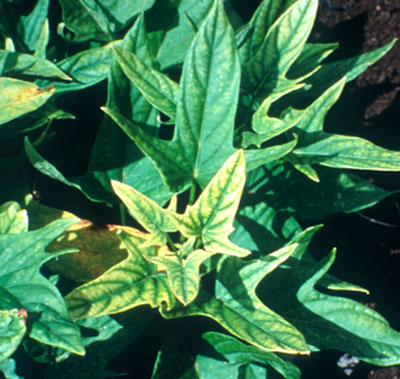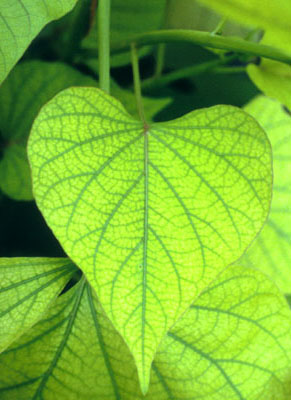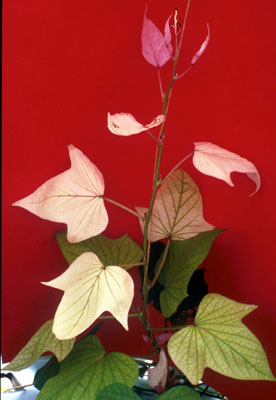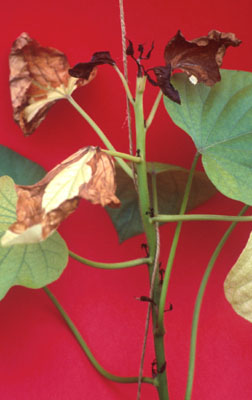|
Iron
(Fe) deficiency is frequently encountered on calcareous
soils. In these soils, the availability of iron to plants is reduced through
precipitation of iron at high pH, or by high
concentrations of phosphorus. Under such conditions, iron deficiency may often
be associated with deficiencies of other micronutrients,
such as manganese, copper and zinc, whose availability is also pH-dependent.
Heavy applications of lime or phosphorus fertilisers can likewise induce iron
deficiency. Iron deficiency may also be expected on sandy soils, organic soils
or acid soils having excessively high levels of manganese.
A number of other disorders which impair
root function, including toxicities of manganese, aluminium or zinc, or calcium
deficiency, can inhibit iron uptake and induce symptoms of iron deficiency in
the leaves. In all cases of iron deficiency, care should be taken to determine
the conditions responsible for the disorder.
Iron deficiency is one disorder where
visible symptoms are obvious when crop growth is only mildly affected, a feature
which probably contributes to the frequent observation of iron deficiency in
sweetpotato crops.
The distinctive symptom of iron
deficiency is chlorosis of the youngest
leaves. As the chlorosis is a result of photobleaching, leaves in bright
sunlight will be more affected than those in shade. Initially, a yellow interveinal
chlorosis develops, which is characterised by a sharply contrasting green
network of veins. However, as the condition becomes more severe, the chlorosis
becomes white and the veins may lose their green colour. If young leaves are
normally purple, they become pink as a result of iron deficiency. While all the
leaves of the plant may become affected, youngest leaves generally show the
greatest intensity. However, if iron supply has been restored, new leaves become
bright green and chlorotic leaves may be found below them.
Severely
affected leaf blades become necrotic, the necrosis usually spreading from the
tip and margins into interveinal zones. Eventually, the growing points may die,
both at the terminal apex and in axillary shoots. Necrotic
tissue on expanded leaf blades is generally light brown and soft, but may be
dark and brittle on the shoot tips.
Boron deficiency may also cause death of
growing points and chlorosis of young leaves, but the chlorosis is not
distinctly interveinal. In particular, the minor veins are not sharply defined,
as is seen in iron deficiency. Also, thickening and deformation of young leaves
is not observed in iron deficiency.
Iron deficiency may be induced by a
number of disorders which adversely affect root function. These include calcium
deficiency and toxicities of manganese, zinc or copper. Correction depends on
identifying the primary cause in these cases.
A critical concentration of 33 mg iron/kg
in the 7th to 9th youngest leaf blades was estimated in solution culture studies
using the cultivar Wanmun. In healthy plants, concentrations were generally
between 45 and 500 mg iron/kg. This is consistent with the findings of Spence
and Ahmad (1967) who reported 35 mg iron/kg dry weight in young shoots of plants
which showed mild symptoms of iron deficiency without growth reduction, and 28
mg iron/kg from plants showing severe chlorosis.
Due to the large number of factors which
affect the availability of soil iron to plants, soil measurements are not
generally reliable for diagnosing iron deficiency.
Diagnosis can be confirmed by painting a
chlorotic leaf with a 1% solution of ammonium ferric sulfate, which will cause
regreening after a few days. It is important to clearly label the painted leaf
so that it can be identified on later inspection. By painting only one half of
the leaf, the other half may be used for comparison of the response (Plate 15g).
Including a small amount of an agricultural wetting agent or mild detergent in
the solution may aid the uniform wetting of the leaf surface, but it is not
essential for sweetpotato leaves, which wet relatively easily.
On soils of high pH, application of iron
compounds as a fertiliser to the soil is likely to give a poor response, as the
added iron will be precipitated and become unavailable to plants. Treatment of
an iron deficient crop is best achieved by a foliar spray of chelated iron or
1-2% ammonium ferric sulfate solution. Burying small pieces of scrap iron, such
as nails and steel food cans, in the mound at planting, can also be effective in
reducing iron deficiency. Soaking cans in sea water before burying accelerates
rusting and has been successful in increasing their effectiveness as an iron
supplement on calcareous atoll soils.
If iron deficiency occurs on an acid
soil, it may be a secondary effect of another nutritional disorder, such as
manganese toxicity or calcium deficiency. In this case, liming may alleviate the
iron deficiency by eliminating the underlying problem.
Bourke,
R.M. 1983. Crop micronutrient deficiencies in Papua New Guinea. Technical Report
83/3, Department of Primary Industry, Papua New Guinea.
Cable, W.J. 1992. Common nutrient deficiency symptoms of
crops of Tokelau and other coral soils and their correction. Journal of South
Pacific Agriculture, 1(2), 43-52.
O’Sullivan, J.N., Asher, C.J. and Blamey, F.P.C. 1997.
Nutrient Disorders of Sweet Potato. ACIAR Monograph No. 48, Australian Centre
for International Agricultural Research, Canberra, 136 p.
Spence,
J.A. and Ahmad, N. 1967. Plant nutrient deficiencies and related tissue
composition of the sweet potato. Agronomy Journal 59, 59-62.
Contributed
by:
Jane O'Sullivan |
Characteristics
and occurrence
Symptoms
Confusion
with other symptoms
Diagnostic
tests
Management
References

Yellowing of younger leaves on iron deficient plant (J.
O'Sullivan).

Typical yellowing between veins with veins sharply contrasting (J.
O'Sullivan).

Very pale chlorosis on young leaves (J. O'Sullivan).

Normally purple tips become pink (J. O'Sullivan).

Necrosis of pale young leaves and death of vine tip and axillary buds
(J. O'Sullivan). |

